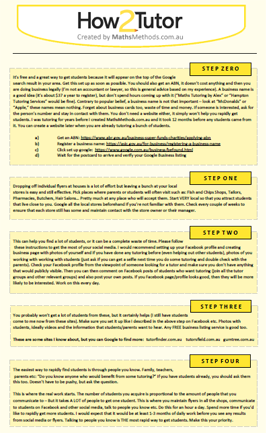To get the best results in a tutoring session there are a few things you need to know! Let's start with the first session.
The purpose of the first session
The purpose of the first session is to help them out with whatever they are having trouble with in class, right now. Sure, they probably have misunderstandings from way back, but it’s too slow to start working on those first. You want to give the students wins.
How to run the session
There are few points that are rarely known, but if you apply them, your students will get much more from your sessions and are more likely to recommend you to other students!
1) Words are important.
In a lot of cases, the reason that a student is having trouble is because they don’t understand the terminology.
For example, ask yourself, what is the definition of the equals sign (=)?
9/10 people I’ve asked who have trouble with Maths get this question wrong.
Some don’t have an answer, some think it’s “gets the result” or “becomes” but it is not. The definition of the equals sign is “equals” or “the same as.”
Seems obvious now, doesn’t it?
No knowing this definition is often why people have so much trouble with Maths in their later years of schooling. They accumulate more and more terminology they have no definition for, rote learn how to answer questions but don’t understand the subject and eventually give up.
In other words, it’s probably a good idea you check with them if they know what all the terminology means in what they are currently studying and then providing definitions when they don’t.
I once had a student who was failing in a subject, I got him to understand the words and he ended up with a B+, just saying…
Also, be very VERY careful to use simple language when you talk. If you use a complicated word, all your doing is adding in extra confusion. Which brings me to the next point!
2) Teach them on step at a time
This is a common error that occurs in a lot of tutors and teachers who are experts in their subject. It’s the reason that some teachers cannot teach. They know it so well, that the answer is obvious and intuitive. The whole subject isn’t a series of steps or rules but a unified whole that they can think with and use. It would be like describing how you get out of bed! You just do it.
But really, you open your eyes, push yourself on to your side, use your arms to push your body up, move to a sitting position, swivel around so your legs are on the ground and push up from the bed with your arms and legs to a standing position. That’s at least 6 steps, each which could actually be explained in much more detail.
You need to understand the viewpoint of the student. When I teach, I take the viewpoint that I don’t know anything and teach the subject as if I am learning it for the first time. This makes it easier to do each part step by step. I will also check with the student how they are going often, and I don’t take the answer “good,” because that’s usually an automated response. I will consult their understand and get them to show me what they know. You can also tell by how they look whether they are understanding it. They should look more energetic and happier if they are understanding something for the first time.
If a student gets confused in your tutoring sessions, chances are that you have given them too much at one time. Go back a step until you find the point they understood well and then build it up slowly from there, checking their understanding after each point you make.
3) Make the subject visual
Students learn in all sorts of different ways, so it’s worth incorporating these into your tutoring sessions. Any subject can be made visual. Draw diagrams, Google pictures, show them a video and make them see what they are studying. There are numerous ways to do this.
The purpose of the next session
It might take a few sessions to get the students to understand what is going on in class, but ideally, you’d cover it in the first tutoring session. The next step is to get them ahead of class, so that when they are in class, it is basically revision. This will build up a lot of confidence. As I mentioned, you may want to get them to watch videos and do exercises in between sessions, that way you can spend you tutoring sessions on the parts they get stuck with rather than try to cover it call.
When you have a student ahead of their class
The student is now ahead of class and feeling a lot more confident. This is the point where you fix up any other areas that the students felt they had problems with. Often, you will need to start at the beginning of the curriculum and work forward. Again, it’s ideal that they cover a lot of this outside of class with videos and exercises.
Tests and assessments
Finally, we all know that school (especially the final years) isn’t just about understanding, it’s also about getting good marks, so you also need to prepare the students for this (sad but true).
If it’s an English class, you would want them to practise doing essays under timed conditions or if it’s a Science or Maths, doing exam questions under timed conditions. The ideal situation, is that they spend all of their homework and tutoring time on this, but of course, this is not productive if they don’t understand the subject they are studying.
This is just a basic rundown on how to approach tutoring, I hope it’s given you some useful tools to use!



Greetings! Very useful advice in this particular article! It is the little changes that produce the greatest changes. Thanks a lot for sharing!